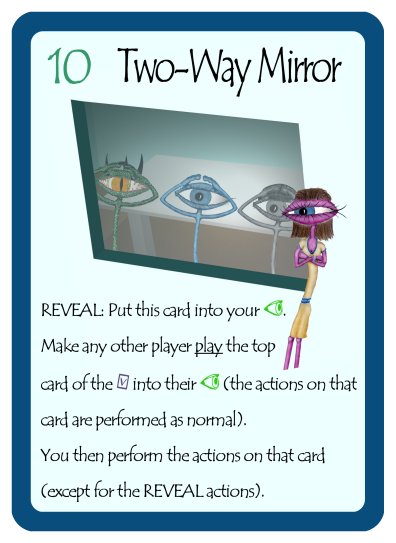|
Whilst, as a designer, I like to keep most game elements simple, I purposefully went against my own guidelines when I created the Two-Way Mirror card for Viewpoint Reflection. I did this because when you understand how Two-Way Mirror works, it becomes really enjoyable to play with. I felt that this was a reasonable compromise so long as I could provide a simple explanation of how the card functions. Read on to see if I accomplished that. The rules text on Two-Way Mirror (10 View-points) states: REVEAL: Put this card into your Field of View. Make any other player play the top card of the Draw Pile into their Field of View (the actions on that card are performed as normal). You then perform the actions on that card (except for the REVEAL actions). So for beginners and even some experienced Viewpoint players, this card looks like it does too many things to bother using. However, in short, using Two-Way Mirror is like giving another player a free card play (from the top of the Draw Pile) and then copying that card play using Two-Way Mirror. i.e. Similar to using the copy ability on Mirror Image. This seems easy enough when playing casually but the real power and enjoyment from using the card comes when you understand the variety of interactions possible with it, which are explained below.
REVEAL The actions on Two-Way Mirror are listed after the REVEAL keyword. This means that it can be revealed at any time, during any player's turn, without costing you a card play. That's right! It is effectively a free card play. Put this card into your Field of View. When Two-Way Mirror is revealed, it is placed into your Field of View. This means that you get 10 View-points for free. So if you have played your normal card play for the turn and you are on 90 View-points, you can reveal Two-Way Mirror during your turn to take your total View-points to 100 and, in most cases, win the game. Make any other player play the top card of the Draw Pile into their Field of View (the actions on that card are performed as normal). All this means is that you choose any other player to take the top card of the Draw Pile, who must then put that card into their Field of View and follow what the actions on that card say. So if the card is Blink, they draw two cards. If it is Blind Spot, they make another player discard one card. However, if there are no cards left in the Draw Pile when the other player attempts to play the top card from it, they do nothing instead. This also means that you can't do the next part of the what the card says because there will be nothing to copy. You then perform the actions on that card (except for the REVEAL actions). If Two-Way Mirror is still in your Field of View after the other player has played the top card of the Draw Pile and performed the actions on the card, and the played card remains in any player's Field of View, you then perform the actions on the card. If the played card has been nullified (i.e. moved to the Discard Pile, to a player's Hand or to the Draw Pile) then there will be no card to copy and nothing else happens. Irrespective of whether or not the played card has been nullified, if Two-Way Mirror is removed from your Field of View, you may not copy the card. Basically, if there is no card to copy or your Two-Way Mirror is no longer in your Field of View then you can't copy anything. However, if the Two-Way Mirror card is moved to another player's Field of View at any time and the played card has not been nullified then the player who has the Two-Way Mirror card may copy it. Note that Two-Way Mirror can only copy a card for each time it is revealed and the card it is copying can't be changed once it has been chosen. Examples of how the played card or Two-Way Mirror may be nullified/removed include:
Examples of how Two-Way Mirror may be used to great advantage:
Because revealing Two-Way Mirror can be a big gamble, your opponent may get far more advantage out of it than you, such as in the following example:
Even though Two-Way Mirror can be a very degenerate card, it is not completely broken when it is used to take another turn. i.e. When it is used to play See Into The Future or Foresight during another player's turn, the extra turn is taken after you have your next turn (or would miss your next turn). There are plenty more devious actions you can perform with Two-Way Mirror but I will leave discovering those up to you. If using the Two-Way Mirror card is still ambiguous or you want some more tips on this card or any other aspect of Viewpoint then feel free to contact our designers.
0 Comments
Leave a Reply. |
Indie Games UnitedIndie Games United is a retailer and advocate of independently designed and published tabletop games. We collaborate with designers and publishers to provide gamers with unique, high quality and novel games. Archives
May 2023
Categories
All
|


 RSS Feed
RSS Feed